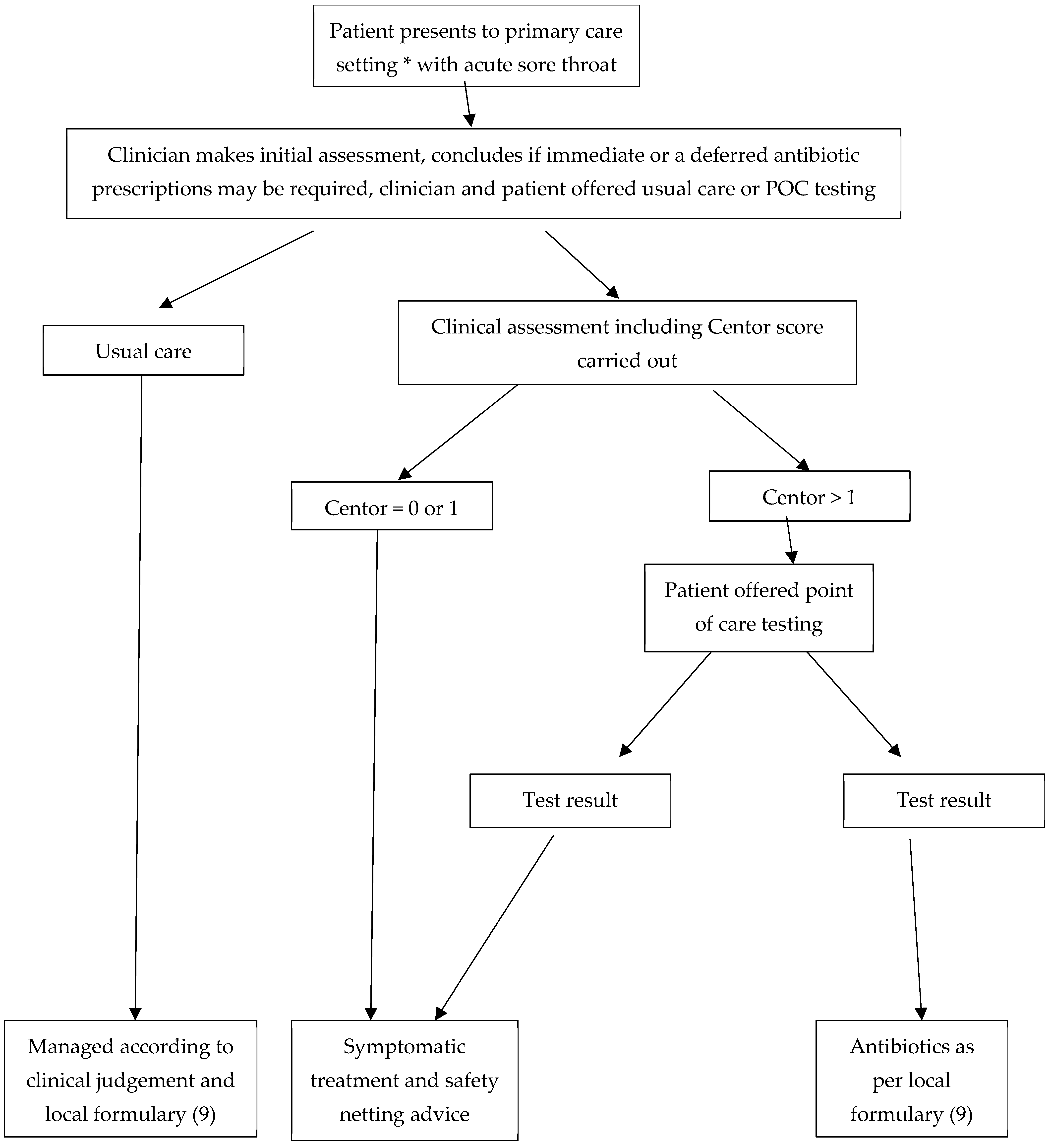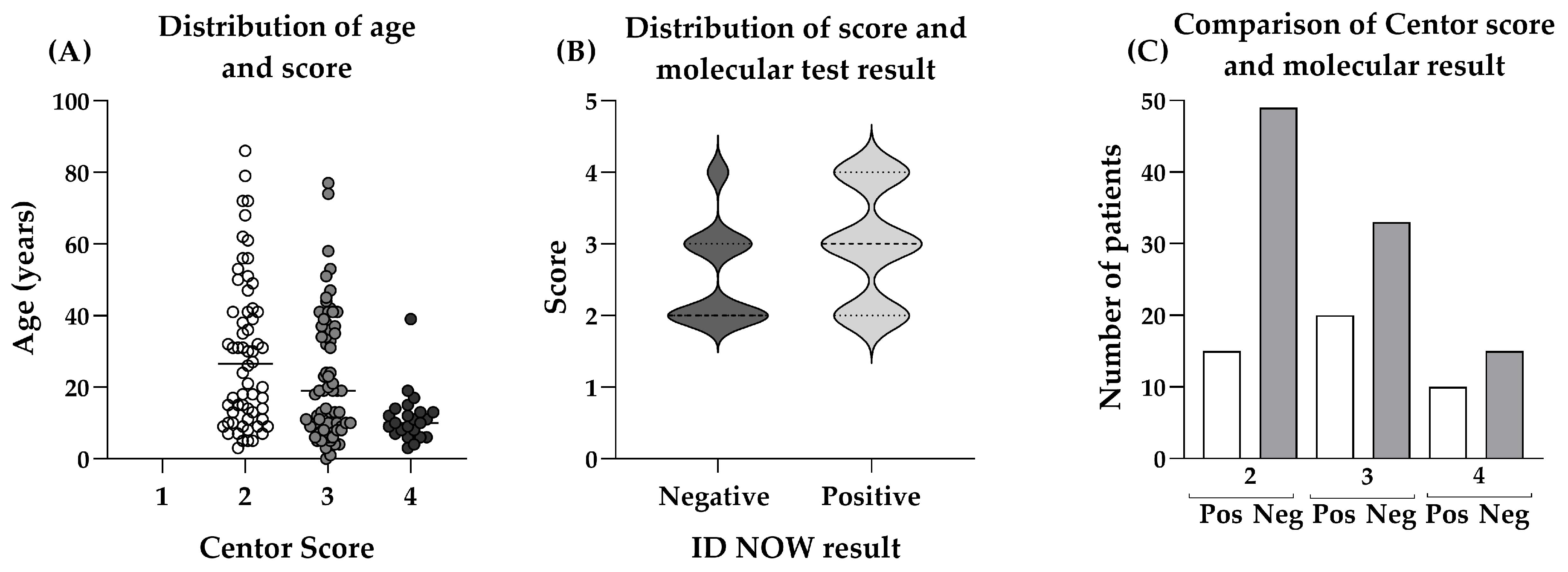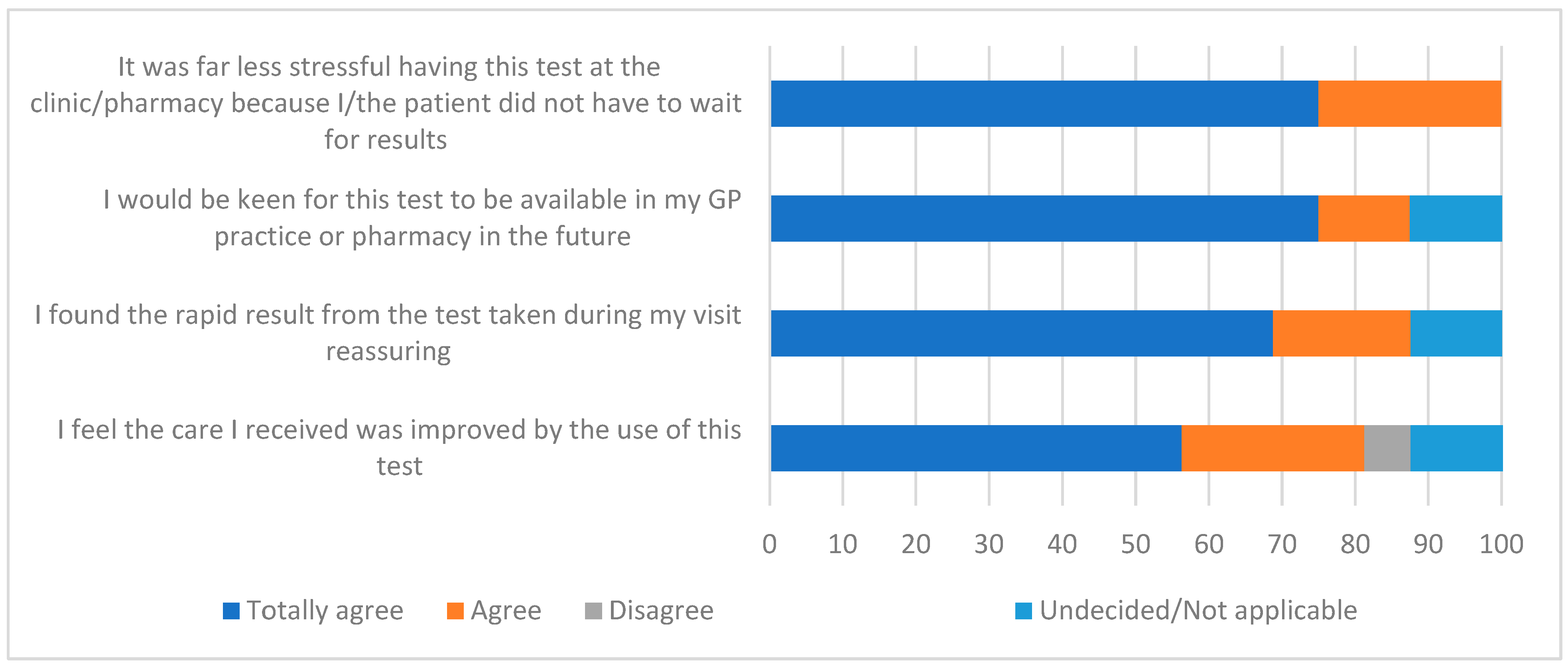Does the Addition of Point-of-Care Testing Alter Antibiotic Prescribing Decisions When Patients Present with Acute Sore Throat to Primary Care? A Prospective Test of Change
Abstract
1. Introduction
2. Materials and Methods
2.1. Study Design
2.2. Clinical Assessment of Patients
2.3. Point-of-Care Testing Molecular Diagnostics
2.4. Study Population
2.5. Data Collection
2.6. Questionnaire
2.7. Statistical Analysis
3. Results
3.1. Molecular POCT Increases the Diagnostic Accuracy of Clinical Evaluation of Strep A Diagnosis
3.2. Longer Consultation Times for POCT Result in Higher Accuracy of Diagnosis
3.3. Patient Responses Following the Availability of Immediate Test Results
3.4. Staff Survey
4. Discussion
5. Conclusions
Author Contributions
Funding
Institutional Review Board Statement
Informed Consent Statement
Data Availability Statement
Acknowledgments
Conflicts of Interest
References
- Mantzourani, E.; Wasag, D.; Cannings-John, R.; Ahmed, H.; Evans, A. Characteristics of the sore throat test and treat service in community pharmacies (STREP) in Wales: Cross-sectional analysis of 11304 consultations using anonymized electronic pharmacy records. J. Antimicrob. Chemother. 2022, 78, 84–92. [Google Scholar] [CrossRef] [PubMed]
- Worrall, G.J. Acute sore throat. Can. Fam. Physician Med. Fam. Can. 2007, 53, 1961–1962. [Google Scholar]
- Bower, J.R. Pharyngitis. In Netter’s Infectious Diseases; Elsevier: Amsterdam, The Netherlands, 2012; pp. 177–182. [Google Scholar] [CrossRef]
- Overview: Sore Throat (Acute): Antimicrobial Prescribing: Guidance NICE. Available online: https://www.nice.org.uk/guidance/ng84 (accessed on 1 March 2024).
- Management of Contacts of Invasive Group A. Available online: https://assets.publishing.service.gov.uk/media/64071ec5d3bf7f25fa417a91/Management-of-contacts-of-invasive-group-a-streptococcus.pdf (accessed on 9 March 2024).
- Group A Streptococccus in Children. NICE Guidelines 2022. Available online: https://www.england.nhs.uk/wp-content/uploads/2022/12/PRN00080-Interim-clinical-guidance-summary-for-case-management-for-prophylaxis-please-refer-to-community-conta.pdf (accessed on 9 March 2024).
- Oliver, J.; Malliya Wadu, E.; Pierse, N.; Moreland, N.J.; Williamson, D.A.; Baker, M.G. Group A Streptococcus pharyngitis and pharyngeal carriage: A meta-analysis. PLoS Neglected Trop. Dis. 2018, 12, e0006335. [Google Scholar] [CrossRef] [PubMed]
- Gulliford, M.C.; Moore, M.V.; Little, P.; Hay, A.D.; Fox, R.; Prevost, A.T.; Juszczyk, D.; Charlton, J.; Ashworth, M. Safety of reduced antibiotic prescribing for self-limiting respiratory tract infections in primary care: Cohort study using electronic health records. BMJ 2016, 354, i3410. [Google Scholar] [CrossRef]
- Thompson, T.Z.; McMullen, A.R. Group A Streptococcus Testing in Pediatrics: The Move to Point-of-Care Molecular Testing. J. Clin. Microbiol. 2020, 58, e01494-19. [Google Scholar] [CrossRef] [PubMed] [PubMed Central]
- Centor, R.M.; Witherspoon, J.M.; Dalton, H.P.; Brody, C.E.; Link, K. The diagnosis of strep throat in adults in the emergency room. Med. Decis. Mak. 1981, 1, 239–246. [Google Scholar] [CrossRef]
- Willis, B.H.; Coomar, D.; Baragilly, M. Comparison of Centor and McIsaac scores in primary care: A meta-analysis over multiple thresholds. Br. J. Gen. Pract. J. R. Coll. Gen. Pract. 2020, 70, e245–e254. [Google Scholar] [CrossRef]
- Nardi, S.; Carolis, L.; Iannini, R.; De Sandro, M.V.; Solito, G.; Calafatti, M.; Gizzi, C. Usefulness of rapid molecular tests in pediatric respiratory tract infections. Ital. J. Pediatr. 2022, 48, 21. [Google Scholar] [CrossRef]
- Varzgalien, L.; Heerey, A.; Cox, C.; McGuinness, T.; McGuire, G.; Cals, J.W.; O’Shea, E.; Kelly, M. Point-of-care testing in primary care: Needs and attitudes of Irish GPs. BJGP Open 2017, 1, bjgpopen17X101229. [Google Scholar] [CrossRef]
- Wolf, F.; Matthes, A.; Markwart, R.; Bleidorn, J. Perspectives of physicians and medical assistants on the implementation of NAAT-based point-of-care testing for SARS-CoV-2 in primary care in Germany. Z. Evid. Fortbild. Qual. Gesundhwes. 2022, 175, 43–49. [Google Scholar] [CrossRef]
- Matthes, A.; Wolf, F.; Bleidorn, J.; Markwart, R. It Was Very Comforting to Find Out Right Away. Patient Perspectives on Point-of-Care Molecular SARS-CoV-2 Testing in Primary Care. Patient Prefer. Adherence 2022, 16, 2031–2039. [Google Scholar] [CrossRef] [PubMed]
- Daniels, R.; Cottin, J.; Khanafer, N. Point-of-Care Testing for SARS-CoV-2: A Prospective Study in a Primary Health Centre. Diagnostics 2023, 13, 1888. [Google Scholar] [CrossRef] [PubMed]
- NHS England. Group A Streptococcus: Reinstatement of NICE Sore Throat Guidance for Children and Young People and Withdrawal of NHS England Interim Guidance. Publication Reference: PR00247. 2023. Available online: https://www.england.nhs.uk/wp-content/uploads/2022/12/PRN00247_Group-A-Streptococcus-reinstatement-of-NICE-sore-throat-guidance-for-children-and-young-people-and-wi.pdf (accessed on 9 March 2024).
- North & East Devon Formulary and Referral. Upper Respiratory Tract Infections. NICE CG69: Respiratory Tract Infections (Self-Limiting): Prescribing Antibiotics. Available online: https://northeast.devonformularyguidance.nhs.uk/formulary/chapters/5-infections/upper-respiratory-tract-infections (accessed on 9 March 2024).
- ID NOWTM Strep A2. Available online: https://dam.abbott.com/en-gb/panbio/ID-NOW-Strep-A%202-Product-Sheet-EME-English.pdf (accessed on 9 March 2024).
- Online Surveys. Available online: https://www.onlinesurveys.ac.uk/ (accessed on 6 April 2024).
- Wächtler, H.; Kaduszkiewicz, H.; Kuhnert, O.; Malottki, K.A.; Maaß, S.; Hedderich, J.; Wiese, B.; Donner-Banzhoff, N.; Hansmann-Wiest, J. Influence of a guideline or an additional rapid strep test on antibiotic prescriptions for sore throat: The cluster randomized controlled trial of HALS (Hals und Antibiotika Leitlinien Strategien). BMC Prim. Care 2023, 24, 75. [Google Scholar] [CrossRef] [PubMed]
- Guy, R.; Henderson, K.L.; Coelho, J.; Hughes, H.; Mason, F.L.; Gerver, S.M.; Demirjian, A.; Watson, C.; Sharp, A.; Brown, C.S.; et al. Increase in invasive group a streptococcal infection notifications, England, 2022. Eurosurveillance 2023, 28, 2200942. [Google Scholar] [CrossRef] [PubMed]
- Allen, T.; Gyrd-Hansen, D.; Kristensen, S.R.; Oxholm, A.S.; Pedersen, L.B.; Pezzino, M. Physicians under Pressure: Evidence from Antibiotics Prescribing in England. Med. Decis. Mak. 2022, 42, 303–312. [Google Scholar] [CrossRef] [PubMed] [PubMed Central]
- Group A Streptococcal Infections: 15th Update on Seasonal Activity in England (No Date) GOV.UK. Available online: https://www.gov.uk/government/publications/group-a-streptococcal-infections-activity-during-the-2022-to-2023-season/group-a-streptococcal-infections-15th-update-on-seasonal-activity-in-england (accessed on 9 March 2024).
- Group A Streptococcus in Children. Available online: https://www.england.nhs.uk/wp-content/uploads/2022/12/PRN00058-group-a-streptococcus-in-children-december-2022.pdf (accessed on 9 March 2024).
- Espaur-Report-2022-TO-2023.PDF. Available online: https://assets.publishing.service.gov.uk/media/65cf498ee1bdec001132225c/ESPAUR-report-2022-to-2023.pdf (accessed on 9 March 2024).
- Further 5 Serious Shortage Protocols (ssps) Phenoxymethylpenicillin Products to Enable the Supply of Alternative Antibiotics, RPS Brandmark. Available online: https://www.rpharms.com/publications/pharmacy-alerts/details/Further-5-Serious-Shortage-Protocols-SSPs-phenoxymethylpenicillin-products-to-enable-the-supply-of-alternative-antibiotics (accessed on 9 March 2024).
- Burdino, E.; Cerutti, F.; Milia, M.G.; Allice, T.; Gregori, G.; Aprà, F.; De Iaco, F.; Aluffi, E.; Micca, G.; Ghisetti, V. Fast and reliable real life data on COVID-19 triaging with ID NOW. J. Clin. Virol. Plus 2022, 2, 100065. [Google Scholar] [CrossRef]
- Barnacle, J.R.; Houston, H.; Baltas, I.; Takata, J.; Kavallieros, K.; Vaughan, N.; Amin, A.K.; Aali, S.A.; Moore, K.; Milner, P.; et al. Diagnostic accuracy of the Abbott ID NOW SARS-CoV-2 rapid test for the triage of acute medical admissions. J. Hosp. Infect. 2022, 123, 92–99. [Google Scholar] [CrossRef]
- Trabattoni, E.; Le, V.; Pilmis, B.; Pean de Ponfilly, G.; Caisso, C.; Couzigou, C.; Vidal, B.; Mizrahi, A.; Ganansia, O.; Le Monnier, A.; et al. Implementation of Alere i Influenza A & B point of care test for the diagnosis of influenza in an ED. Am. J. Emerg. Med. 2018, 36, 916–921. [Google Scholar] [CrossRef]
- O’Connell, S.; Conlan, C.; Reidy, M.; Stack, C.; Mulgrew, A.; Baruah, J. The impact of point-of-care testing for influenza A and B on patient flow and management in a medical assessment unit of a general hospital. BMC Res. Notes 2020, 13, 143. [Google Scholar] [CrossRef]
- Gunnarsson, R.K.; Orda, U.; Elliott, B.; Heal, C.; Gorges, H.; Glasziou, P.; Del Mar, C. Improving antibiotics targeting using PCR point-of-care testing for group A streptococci in patients with uncomplicated acute sore throat. Aust. J. Gen. Pract. 2021, 50, 76–83. [Google Scholar] [CrossRef]
- NIHR. Available online: https://www.nihr.ac.uk/search-results.htm?search=tariff (accessed on 4 March 2024).
- Mikulic, M. Top Antibacterial Drugs Dispensed in England by Items 2022, Statista. 2023. Available online: https://www.statista.com/statistics/377978/top-ten-antibacterial-drugs-dispensed-by-item-in-england/ (accessed on 9 March 2024).
- NHS Choices. Available online: https://www.england.nhs.uk/primary-care/pharmacy/pharmacy-first/ (accessed on 1 March 2024).
- Seeley, A.; Fanshawe, T.; Voysey, M.; Hay, A.; Moore, M.; Hayward, G. Diagnostic accuracy of Fever-PAIN and Centor criteria for bacterial throat infection in adults with sore throat: A secondary analysis of a randomised controlled trial. BJGP Open 2021, 5, BJGPO.2021.0122. [Google Scholar] [CrossRef] [PubMed]




| Centor Score | POCT Results: Positive | Negative | % Positive (95% Confidence Interval) |
|---|---|---|---|
| 2 | 15 | 51 | 22.73 (14.18 to 34.28) |
| 3 | 20 | 33 | 37.74 (25.91 to 51.22) |
| 4 | 15 | 10 | 60.00 (40.70 to 76.64) |
| 3 or 4 | 35 | 43 | 44.87 (34.33 to 55.89) |
| Total | 50 | 94 | 34.72 (27.42 to 42.81) |
Disclaimer/Publisher’s Note: The statements, opinions and data contained in all publications are solely those of the individual author(s) and contributor(s) and not of MDPI and/or the editor(s). MDPI and/or the editor(s) disclaim responsibility for any injury to people or property resulting from any ideas, methods, instructions or products referred to in the content. |
© 2024 by the authors. Licensee MDPI, Basel, Switzerland. This article is an open access article distributed under the terms and conditions of the Creative Commons Attribution (CC BY) license (https://creativecommons.org/licenses/by/4.0/).
Share and Cite
Daniels, R.; Miles, E.; Button, K. Does the Addition of Point-of-Care Testing Alter Antibiotic Prescribing Decisions When Patients Present with Acute Sore Throat to Primary Care? A Prospective Test of Change. Diagnostics 2024, 14, 1104. https://doi.org/10.3390/diagnostics14111104
Daniels R, Miles E, Button K. Does the Addition of Point-of-Care Testing Alter Antibiotic Prescribing Decisions When Patients Present with Acute Sore Throat to Primary Care? A Prospective Test of Change. Diagnostics. 2024; 14(11):1104. https://doi.org/10.3390/diagnostics14111104
Chicago/Turabian StyleDaniels, Rob, Esther Miles, and Karen Button. 2024. "Does the Addition of Point-of-Care Testing Alter Antibiotic Prescribing Decisions When Patients Present with Acute Sore Throat to Primary Care? A Prospective Test of Change" Diagnostics 14, no. 11: 1104. https://doi.org/10.3390/diagnostics14111104
APA StyleDaniels, R., Miles, E., & Button, K. (2024). Does the Addition of Point-of-Care Testing Alter Antibiotic Prescribing Decisions When Patients Present with Acute Sore Throat to Primary Care? A Prospective Test of Change. Diagnostics, 14(11), 1104. https://doi.org/10.3390/diagnostics14111104






